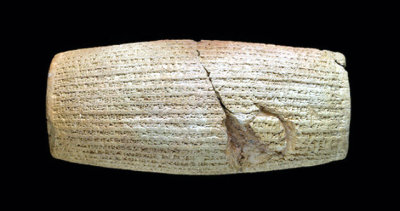Cyrus Cylinder Confirming Biblical Account of Persian King to Tour US

The Cyrus Cylinder, cited as extra-biblical evidence of an Old Testament account involving the exile of ancient Jews, is scheduled to make stops at various museums in the U.S. this year, before returning to its home at the British Museum.
The artifact is named after the Persian king who ruled from 559-530 B.C. and is mentioned in historical and prophetic books of the Bible as having allowed Jews exiled by the Babylonians to return to their home in Jerusalem.
The nearly 2,600-year-old Cylinder is viewed as inspiring modern-day political debates, cultural rhetoric and philosophy, and is also cited as an early example of sensitivity to tolerance, justice and religious freedom.
"One of the goals of this exhibition is to encourage us to reflect that relations between Persians and Jews have not always been marked by the discord that disfigures the political map of the Near East today," said Julian Raby, The Dame Jillian Sackler Director of the Arthur M. Sackler Gallery and the Freer Gallery of Art. "Cyrus was the very image of a virtuous ruler — inspiring leaders from Alexander the Great to Thomas Jefferson — so it is apt that the first time the Cyrus Cylinder will be seen in the West is in Washington, D.C."
The football-sized, barrel-shaped clay item covered in Babylonian cuneiform, believed to have been written some time after 539 B.C., tells of King Cyrus' "victory and his intention to allow freedom of worship to communities displaced by the defeated ruler Nabonidus," according to the Smithsonian museum.
From March 9 to April 28, the Cyrus Cylinder will be available for public viewing at the Smithsonian's Arthur M. Sackler Gallery in Washington, D.C. The Babylonian artifact will then be put on display at locations in Houston, New York, San Francisco and Los Angeles. A copy of the ancient artifact is housed at the United Nations in New York City.
The item is of particular importance to archaeologists and biblical scholars, as it appears to match accounts mentioned in the Books of 2 Chronicles, Daniel, Isaiah and Ezra regarding the Babylonian and Persian Empires, as well as Jewish displacement from Jerusalem.
"When the Cylinder was rediscovered in 1879, it immediately entered the fray of public debate as invaluable proof of the historical veracity of events described in biblical scripture," notes a statement from the Smithsonian. "When contextualized with other contemporary sources, such as the Bible's Book of Ezra, it becomes evident that Cyrus allowed displaced Jews to return to Jerusalem."
The Cyrus Cylinder was discovered in the ruins of Babylon, or Nineveh, Iraq, in 1879 by Hormuzd Rassam, an archaeologist and a Christian.
A translation of the legible writing that remains on the Cylinder was made available by the British Museum. An excerpt of King Cyrus' declarations reads: "I sought the safety of the city of Babylon and all its sanctuaries. As for the population of Babylon […, w]ho as if without div[ine intention] had endured a yoke not decreed for them, I soothed their weariness; I freed them from their bonds(?). Marduk, the great lord, rejoiced at [my good] deeds, …"
John Curtis, keeper of Special Middle East Projects at the British Museum, is curating the Cylinder's tour across the U.S., which will include stops at the Museum of Fine Arts in Houston, the Metropolitan Museum of Art in New York, the Asian Art Museum in San Francisco and the J. Paul Getty Museum at the Getty Villa in Los Angeles through October.





























